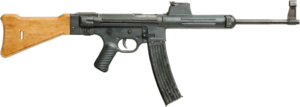
StG 45(M)
The StG 45(M) (Sturmgewehr 45 literally "storm rifle" or "assault rifle 1945") sometimes referred to as the MP 45(M), was a prototype assault rifle developed by Mauser for the Wehrmacht at the end of World War II, using an innovative roller-delayed blowback operating system. It fired the 7.92×33mm Kurz (or "Pistolenpatrone 7.9mm") intermediate cartridge at a cyclic rate of around 450 rounds per minute.
Overview
The origin of this rifle can be traced back to the final years of World War II when Mauser engineers at the Light Weapon Development Group (Abteilung 37) at Oberndorf am Neckar designed the MKb Gerät 06 (Maschinenkarabiner Gerät 06 or "machine carbine instrument 06") prototype assault rifle chambered for the intermediate 7.92×33mm Kurz cartridge, first with the Gerät 06 model using a roller-locked short recoil mechanism originally adapted from the MG 42 machine gun, but with a fixed barrel and conventional gas-actuated piston rod. It was realized that with careful attention to the mechanical ratios, the gas system could be omitted. The resultant weapon, the Gerät 06H (the "H" suffix is an abbreviation for halbverriegelt or "half-locked") was assigned the designation StG 45(M) (Sturmgewehr 45(M)).

Rk 62
The Rk 62 (also 7.62 RK 62 and M62; Rynnäkkökivääri 62 or "assault rifle 62") is an assault rifle manufactured by Valmet and Sako. It is the standard issue infantry weapon of the Finnish Defence Forces.
The Rk 62 was designed in 1962 and is based on the Polish licensed version of the Soviet AK-47 design. The Rk 62 uses the same 7.62×39mm cartridge as the AK-47. Between 1965 and 1994 350,000 M62 rifles were produced jointly by Valmet and Sako. It is the basis of the IMI Galil, an Israeli-made assault rifle with many similarities.
The Rk 62 has a three-pronged flash suppressor, and a groove for a specially designed knife bayonet, which can be used alone as a combat knife. The Rk 95 Tp is a more modern, improved version of the Rk 62. One of the most distinctive features of the Valmet rifles, including the M62 and all subsequent variations, is the open-ended, three prong flash suppressor with a bayonet lug on its lower side. In addition to the flash suppression, the end can quickly cut barbed wire by pushing the muzzle onto a strand of wire and firing a round - noisy but effective.

FN FAL
The Fusil Automatique Léger ("Light Automatic Rifle") or FAL is a semi-automatic/selective fire battle rifle produced by the Belgian armaments manufacturer Fabrique Nationale de Herstal (FN). During the Cold War it was adopted by many North Atlantic Treaty Organization (NATO) countries, with the notable exception of the United States. It is one of the most widely used rifles in history, having been used by more than 90 countries.
The FAL was predominantly chambered for the 7.62×51mm NATO round (although originally designed for the .280 British intermediate cartridge) and because of its prevalence and widespread use among the armed forces of many NATO countries during the Cold War it was nicknamed "The right arm of the Free World".
A British Commonwealth derivative of the FN FAL has been produced under licence as the L1A1 Self-Loading Rifle.
History
In 1946, the first FN FAL prototype was completed. It was designed to fire the intermediate 7.92×33mm Kurz cartridge developed and used by the forces of Nazi Germany during World War II (see StG44 assault rifle). After testing this prototype in 1948, the British Army urged FN to build additional prototypes, including one in bullpup configuration, chambered for their new .280 British caliber intermediate cartridge. After evaluating the single bullpup prototype, FN decided to return instead to their original, conventional design for future production.
Sturzkampfgeschwader 3
Sturzkampfgeschwader 3 (StG 3) was a Luftwaffe Dive bomber-wing of World War II. It was formed on 9 July 1940 in Dinard from the Stab/Kampfgeschwader 28 and redesignated to Schlachtgeschwader 3 on 18 October 1943.
Commanding officers
Kommodore
Gruppenkommandeure
I./StG 3
II./StG 3
Podcasts:

